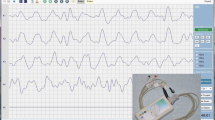Abstract
An inexpensive four-channel data logger for recording gastrointestinal potentials is described. A 512 K bytes memory and a sampling speed of 1·25 Hz per channel is adequate for these potentials and permits recordings for up to 27 hours. The small size and light weight allow the device to be carried in a pocket so that recordings can be made while the subject is freely ambulatory. A separate replay unit allows the data stored in the data logger to be presented to a chart recorder or to an interface card in a PC AT. This interface, a Microsoft C vers 5.0 program and the computer display the data as single frames or scrolled, expanded or condensed on either the time or amplitude axis. From the computer the data can be written to a printer and displayed as a chart or to an ASCII format file which can be used for analysis with statistical packages. Examples of recordings from both man and dog are illustrated and the analogue recorded data are compared with data digitally recorded. It is suggested that the data logger has many applications where long-term slow potential changes must be recorded under specially difficult conditions.
Similar content being viewed by others
References
Ask, P., Öberg, P. A., andTibbling, L. (1979) Frequency content of esophageal peristaltic pressure.Am. J. Physiol.,236, E296-E300.
Barnett, T. G., Koeze, T. H., Pilot, M. A., andQin, X. Y. (1987) Microcomputer analysis and display of canine small intestinal electrical activity.Med. & Biol. Eng. & Comput.,25, 672–676.
Bass, P. andWiley, J. N. (1972) Contractile force transducer for recording muscle activity in unanaesthetized animals.J. Appl. Physiol.,32, 567–570.
Berkson, J., Baldes, E. J., andAlvarez, W. C. (1932) Electromyographic studies of the gastrointestinal tract. I. The correlation between mechanical movement and changes in electrical potential during rhythmic contraction of the intestine.Am. J. Physiol.,102, 683–692.
Fioramonti, J. andBueno, L. (1982) Diurnal changes in colonic motor profile in conscious dogs.Dig. Dis. & Sci.,28, 257–264.
Kumar, D., Soffer, E. E., Wingate, D. L., Britto, J., Das-Gupta, A. andMridha, K. (1989) Modulation of the duration of human postprandial motor activity by sleep.Am. J. Physiol.,256, (Gastrointest. Liver Physiol.,19) G851-G855.
Shannon, C. E. (1949) Communication in the presence of noise.Proc. IRE,37,(1), 10–21.
Sarna, S. K., Condon, R., andCowles, V. (1984) Colonic migrating and nonmigrating motor complexes in dogs.Am. J. Physiol.,246, G355-G360.
Szurszewski, J. S. (1987) Electrical basis for gastrointestinal motility. InPhysiology of the digestive tract, 2nd edn.Johnson, L. R. (Ed.), Raven Press, New York.
Author information
Authors and Affiliations
Rights and permissions
About this article
Cite this article
Barnett, T.G., Koeze, T.H., Meeks, D.R. et al. Versatile digital data logger: storage of gastrointestinal motility data. Med. Biol. Eng. Comput. 28, 187–192 (1990). https://doi.org/10.1007/BF02441776
Received:
Accepted:
Issue Date:
DOI: https://doi.org/10.1007/BF02441776




